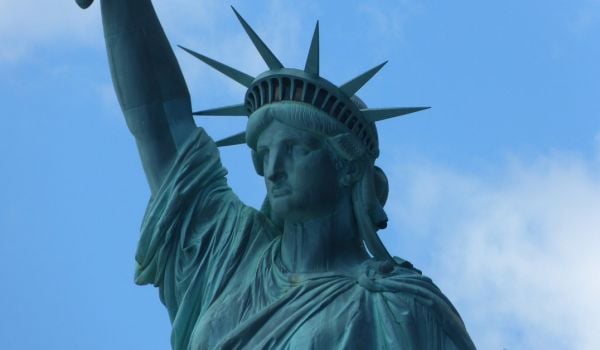What does financial empowerment look like? You could say it looks like a lot of paperwork. Or anxiously waiting for your turn to walk into the back office of a bank or other loan provider. But those are just moments. Like the rest of our financial lives, the whole process of financial empowerment remains largely a mystery, even to those who would play a role in facilitating it. If you’re new to this country, it’s just one more factor stacking the odds against you.
Even where financial empowerment opportunities exist specifically for immigrants, uptake is scarce.
“One of the things we started noticing since this administration began was that data from prior years showed very few immigrants actually took up loan programs created specifically for them,” says Nisha Agarwal, commissioner of the NYC Mayor’s Office of Immigrant Affairs (MOIA).
Such loans could help secure a new apartment, purchase a new car, pay tuition for college or other classes — but above all, Agarwal says, loans help pay for fees associated with naturalization or deferred action for child arrivals. Such fees can be around $500 to $600 per person, and often whole families want to apply at one time.
To help close the gaps between immigrants and the financial empowerment programs meant for them, MOIA just launched a partnership with the New School’s Parsons School of Design. It’s part of a series of projects under the umbrella of Designing for Financial Empowerment, an ongoing Citi-funded collaboration among Parsons, the Mayor’s Fund to Advance New York City, and city agencies like MOIA.
Issues of financial empowerment and financial barriers of various types frequently come up in MOIA’s various listening tours and discussions in communities around the city, Agarwal says.
Service design is a relatively newer sub-field within design, a world typically associated with iconic products like the iMac or iPhone. Taking those same research and prototyping methods into services, the largest sector of our economy, is a relatively new but accelerating trend. Outside the U.S., design methods are also popping up in public services.
Last Saturday, Parsons hosted the eighth Service Design Network Global Conference. It’s where MOIA announced the partnership with Parsons.
“We’re learning this new technique for solving problems and improving services that we deliver. I imagine we’ll keep using it moving forward,” Agarwal says.
At Parsons, public service design finds its home at the Design for Social Innovation and Sustainability (DESIS) Lab, where Eduardo Staszowski is director. DESIS looks at social innovation on two levels.
“We look at the grassroots level to find what’s already happening and amplify if it’s worth it,” Staszowski says. “And we look at sensitizing governments, mostly city governments, to look at innovations, and to open up processes for designing or co-designing policies and services.”
Sometimes in courses, sometimes in extracurricular settings, DESIS begins by seeking to engage with as many different perspectives as possible related to a given process, like financial empowerment, or more specifically in this instance, how to apply for and access a loan for the purposes of immigration and naturalization fees.
“It’s a very qualitative process. Before we do anything ideally we start talking to people on the streets,” Staszowski says.
The first project DESIS worked on as part of the Designing for Financial Empowerment collaboration was a project with the Department of Consumer Affairs, focusing on the tax filing process. Community partners like the Food Bank of New York were essential to that project, and they are again for MOIA’s work with Parsons. It’s exciting for Agarwal, a lawyer who came out of the immigrant rights and racial justice advocacy world.
“We can’t do any of our work without community groups’ active partnership,” she says.
Other stakeholders will also be key to the next step after gathering community perspectives — mapping out the financial empowerment process. It will allow everyone to see literally what financial empowerment looks like, revealing whether it is ugly or elegant. For MOIA, libraries are also essential partners for this project.
“They are without a doubt one of the places where immigrant families feel safest,” Agarwal says. “The most popular libraries around the city tend to be in very immigrant-rich neighborhoods. Libraries are a natural partner for us.”
Various branches of New York City’s three library systems already host a range of key programs with an emphasis on immigrant populations. Among them, the city’s IDNYC program that provides any city resident with a government-issued ID from the city, giving them easier access to public benefits as well as bank accounts at a dozen financial institutions and counting that accept the ID.
After mapping out the process and the challenges faced by target populations, the next phase is to have everyone brainstorm, in a structured way, ideas to improve the process.
“We don’t have a set of fixed tools. We design tools according to each set of people and problems we face together,” Staszowski says. “We try to generate empathy within the system, open conversations and create those a-ha moments.”
In the tax filing project they came up with a menu of 60-70 ideas. They then whittled down to the three most feasible to test and prototype. With the other partners, DESIS is discussing now how to implement at least one idea at scale during the upcoming tax season.
Citi’s support is vital to the whole process, Staszowski says, as it helps create space for creativity and risk-taking that might not otherwise be there if the partnership was funded using only taxpayer dollars.
For now, the MOIA project is still in the listening phase. It’s important for the success of redesigning the financial tools available for those new to the country. But it’s more than that.
“We want people to feel part of government, not just be passive recipients. Empowerment also means more active citizen participation,” Staszowski says. “Opening up possibilities for new forms of governance, partnerships and collaboration.”
The Equity Factor is made possible with the support of the Surdna Foundation.

Oscar is Next City's senior economic justice correspondent. He previously served as Next City’s editor from 2018-2019, and was a Next City Equitable Cities Fellow from 2015-2016. Since 2011, Oscar has covered community development finance, community banking, impact investing, economic development, housing and more for media outlets such as Shelterforce, B Magazine, Impact Alpha and Fast Company.
Follow Oscar .(JavaScript must be enabled to view this email address)

















